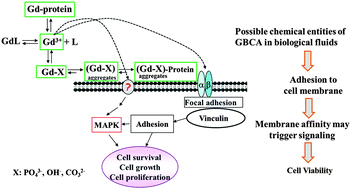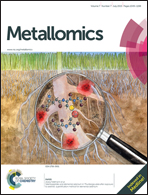The gadolinium-based contrast agent Omniscan® promotes in vitro fibroblast survival through in situ precipitation
Abstract
The current study aims to explore how the gadolinium (Gd)-based contrast agent (GBCA) Omniscan® enhanced cell viability of murine fibroblasts. The results of scanning electron microscopy showed that Omniscan® can precipitate in cell culture media and deposit on cell membranes. Energy-dispersive X-ray analysis and Fourier-transform infrared spectroscopy demonstrated the presence of Gd and phosphates in the agglomerated particles. By filtering the Omniscan®-containing medium through a 220 nm filter, it can be clearly found that the increased cell viability should be mainly attributed to the insoluble species of gadolinium rather than to chelated gadolinium. Moreover, the effects of other gadolinium-based contrast agents, Magnevist® and Dotarem®, were compared with that of Omniscan®. It is noted that the three contrast agents differed in their ability to induce cell viability, which is possibly ascribed to the different chemical stabilities of gadolinium chelates as demonstrated by the attenuation in cell growth upon the addition of excess ligands to the compounds. The results of flow cytometry analysis also showed that Omniscan® can promote cell growth via an increase in the S-phase cell population as evidenced by the elevated levels of cell cycle associated proteins cyclin D, cyclin A and the phosphorylated Rb protein. Furthermore, our results revealed that integrin-mediated signaling may play an important role in both Omniscan® and Magnevist®-enhanced focal adhesion formation since the blockade of integrins decreased the level of ERK phosphorylation induced by the two GBCAs. Taken together, these data suggested that in situ gadolinium phosphate precipitation formation mediated Omniscan®-promoted fibroblast survival, which is similar to that of gadolinium chloride. It was demonstrated that the application of GBCAs with more stable thermodynamic stability may cause less dissociation of the gadolinium ion and thus resulted in less precipitation, finally leading to lower occurrence of nephrogenic systemic fibrosis. The obtained results would also be helpful for the development of safe gadolinium-based contrast agents.


 Please wait while we load your content...
Please wait while we load your content...